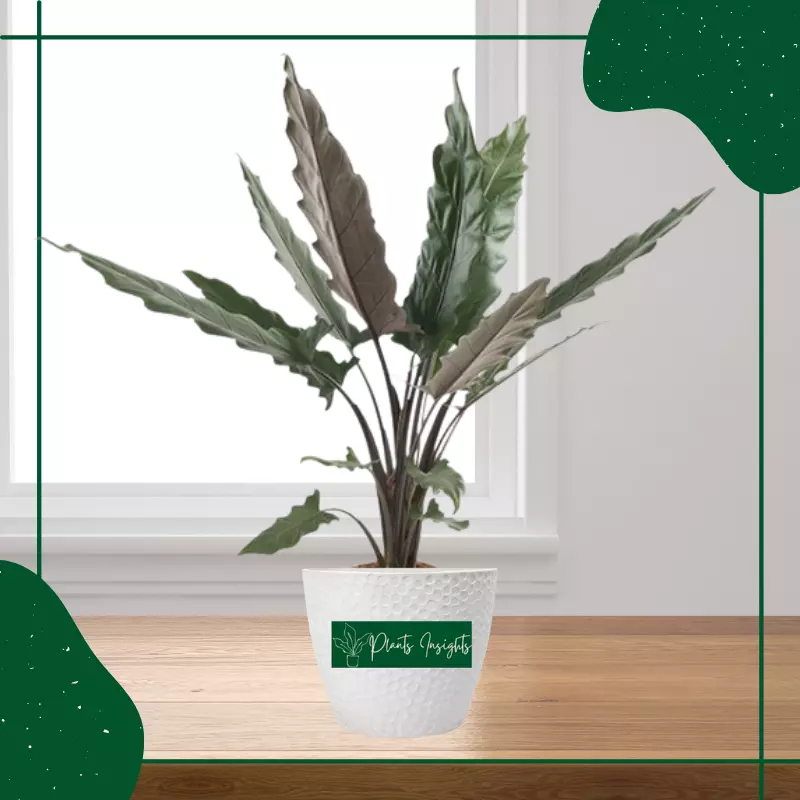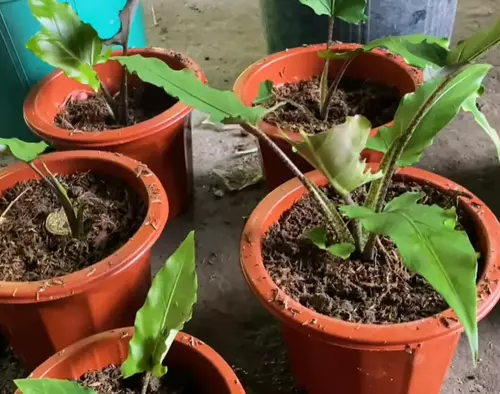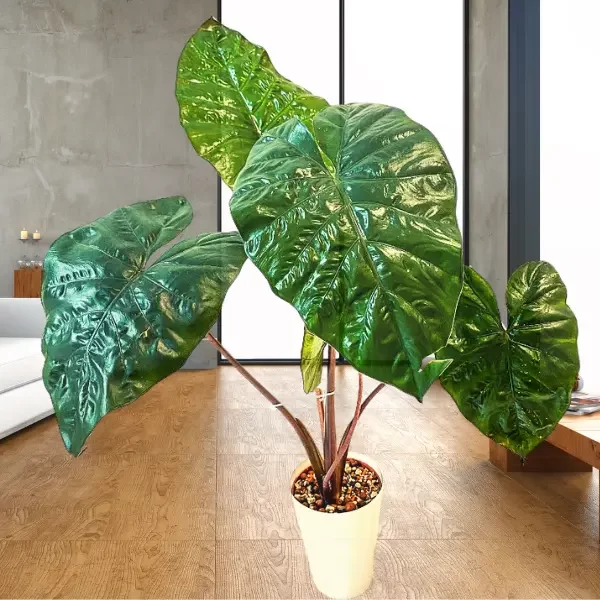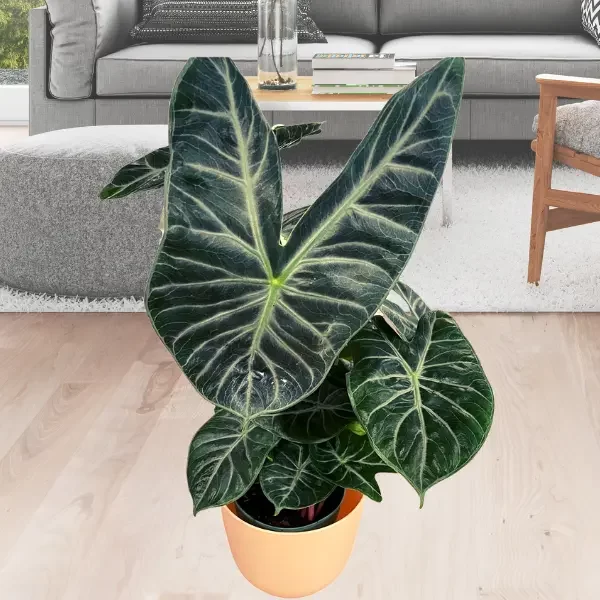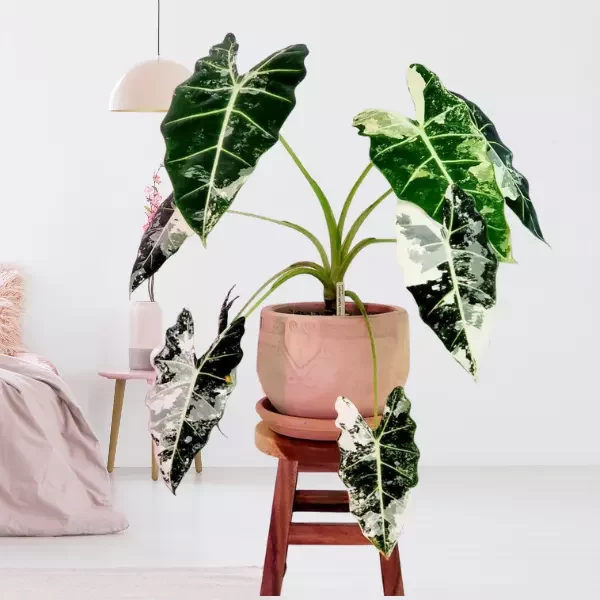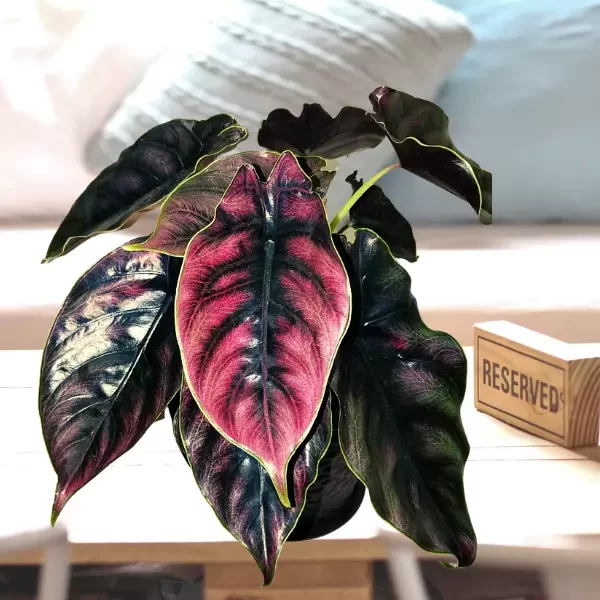Alocasia Lauterbachiana often referred to as the Purple Sword or Elephant’s Ear Plant, is a perennial plant that belongs to the Araceae family. It is native to the Southeast Asian region. This tropical plant has large, spear-shaped greenish-purple leaves with sharp edges and shades of purple that are stunning. Their huge leaves and intriguing colours make them unique species of Alocasia.
Furthermore, the leaves can be up to two feet long and are a must for every plant lover due to their appearance, form, shape, and charm. Alocasia Lauterbachiana is very popular in the Philippines, particularly in provinces like Cagayan and Isabela. It is typically planted as an ornamental plant in gardens.
Allied Species: Alocasia Sarian, Alocasia Silver Dragon, Alocasia Pink dragon, Alocasia Stingray, Alocasia Tiny Dancer, Alocasia Dark Star, Alocasia Portora, Alocasia Cucullata, Alocasia Cuprea, Alocasia Maharani.
Related Products:
Habitat & Ecology
| Botanical Name: | Alocasia Lauterbachiana |
| Family Name: | Araceae |
| Common names: | Purple sword plant, Baroque Sword Plant, Elephant Ear Plant, Silver Sword |
| Plant type: | Tropical flowering perennial plant |
| Origin: | Native to Southeast Asia |
| Hardiness zone | 9b to 11 |
| Height: | 3 feet tall |
| Humidity: | 60 -75 % |
| Temperature: | 65 to 72° F |
| Spread: | 2-3 feet |
| Growth Habit: | Clumping, Upright |
How do you care for Alocasia Lauterbachiana?
Alocasia Lauterbachiana is a tropical plant that grows in warm tropical areas of the world. The Purple Sword plant grows indoors as well as outdoors and requires little maintenance. This plant grows well in moist soil under high humidity and bright light. Here is the complete guide and valuable tips to take care of the Alocasia Lauterbachiana plant.

Initial Home Care for Alocasia Lauterbachiana
This tropical houseplant can grow up to two feet wide, but it can be kept in a pot or container as small as a terra-cotta planter. Although this plant doesn’t need much care, you should consider a few things while introducing Alocasia Lauterbachiana to your home.

Lighting | Do Elephant Ears prefer Sun or Shade?
Alocasia Lauterbachiana prefers bright light, but it can tolerate some shade too. The plant must avoid direct sunlight, which can cause leaf burn or wilt.
The best location is to place the Purple Sword Plant near an east-facing window in an area that receives about six hours of sunlight each day. If you want to ensure the plant is not burnt, you can also grow it under fluorescent lights.

Watering | How do you Water Alocasia Lauterbachiana?
We recommend using rainwater or distilled water to fulfil the watering needs of your Alocasia Lauterbachiana. The minerals in tap water like chlorides and fluorides negatively impact plant health.
The Purple Sword plant is a moisture-loving plant; however, it does not prefer sitting in overly wet soil. Please ensure the soil has become partially dry before you water it. You may check soil moisture level by feeling or using a soil moisture meter.
An Alocasia Lauterbachiana growing in wet soil will have excessive yellowing of leaves and can become prey to root rot, a fungal disease of roots. In contrast, an underwatered plant will show symptoms of drooping leaves and lack of freshness.
The plant requires more watering in summer as it is the peak growth period, and you may have to water the plant two to three times a week depending upon how quickly the soil is drying. Whereas in winter, the plant water requirements and depletion rate drastically reduce, and you may have to water the plant weekly.

Humidity and Temperature
Alocasia Lautrbachianas come from the tropics and will like any extra humidity they can receive. The plant loves humid conditions exceeding 70%, which is quite unusual indoors.
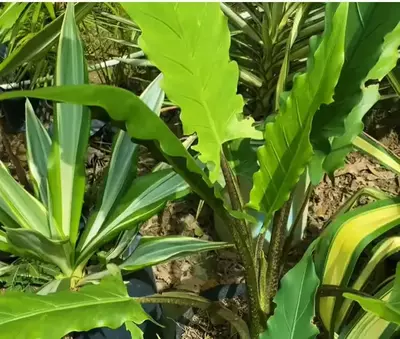
There are many methods to create the right amount of humidity for your plant, including:
Alocasia Lauterbachiana’s best growth occurs in moderately warm conditions. They’re perfectly content with temperatures between 65 and 75° Fahrenheit. One thing that plant owners have to be aware of is that these plants cannot withstand cold temperatures.
If the temperature drops below 60° F, the plant will start to strain. The leaves will begin to fall, and growth will decrease dramatically. Make sure you keep the plant in a cozy area, particularly during the colder months.

Fertilizer | Should the Purple Sword plant be fertilized?
Lauterbachiana Alocasia is a vigorous grower, so fertilizing will make your Purple Sword plant foliage stand out. We recommend feeding the plant through the growing season, from spring to fall and please avoid fertilizing in winter. Use half-strength liquid fertilizers to avoid fertilizer burn and mineral buildup.
The best time to begin fertilizing the Purple Sword plant is in spring and continue to fertilize once per month during summer. If necessary, you can increase fertilization to twice per month, but Alocasia plants thrive without much fertilization.

Purple Sword Plant Soil Requirements
Alocasia Lauterbachiana grows best in well-draining soil. It doesn’t have to be too heavy or too light. It should be capable of holding moisture without soaking the roots. A mix of loamy and sandy soils will benefit the Alocasia Lauterbachiana.
You can also search for soil mix mixes typically made for tropical plants. These potting mixes contain Coconut Coir, Peat moss and coarse sand.
Alocasia Lauterbachiana can grow well in soil with pH levels between 5.5 and 6.5.

Repotting | When Do You Repot Alocasia Lauterbachiana?
Repotting the Alocasia Lauterbachiana plant will help keep it healthy and prevent roots from becoming damaged by overgrowth as they grow outwards from the pot. You may repot a mature Alocasia Lauterbachiana every year; however, you don’t need to transfer your plant to another container within the first two years, but you can refresh the soil.
Choose a pot slightly bigger than the one you have now. It should drain well and be sturdy enough to hold the plant.
If your pot is too large, you will need to water it more often, so the moisture reaches all the roots. This practice can cause the problem because it will take longer for soil to dry, increasing the likelihood of root rot.
The plant is not afraid of being pot-bound, so make sure you choose a pot that fits the roots and doesn’t take up too much space. If the plant is visibly larger than its pot, it should be moved to a larger pot. To replace the old mix, use a well-draining and nutrient-rich soil mix.
Here are the steps of repotting.
Repotting shall be carried out in early spring before which is the beginning of the growth season.

How do you propagate Alocasia Lauterbachiana?
Similar to other Alocasias, baroque Sword Alocasia grow from underground rhizomes. These plants work well with the basal offset division. The rhizomes can be easily divided to make it easier to grow the plant. It is best to do this in the spring or summer, and repotting is an excellent opportunity to propagate Alocasia Lauterbachiana.
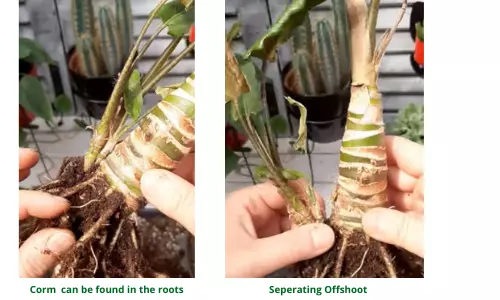
A mature, larger plant can produce offshoots that can be separated from the parent plant after they have developed a sufficient root network.
Follow these steps to successfully propagate Purple Sword plants.

Maintenance (Cleaning and Pruning)
Regular maintenance is required for Purple Sword Alocasia plants. There are many reasons to prune your beloved plant.
Your beautiful plant may have yellowed leaves at the base. This is normal. It is possible to give your plants a little attention by trimming off any yellowing or dying foliage. Pruning can help increase the plant’s growth as plant energy is diverted toward developing healthy leaves.
You may also want to prevent the spread of fungal infections or diseases to your plants’ leaves. Please follow a foliage cleaning practice to reduce the risk of infestation. You may use a wet cloth to clean the leaves regularly.

Pests and Diseases | How to control pests on Alocasia?
The Alocasia are more susceptible to insect pests and fungal diseases than many other plants. They are most vulnerable when they grow rapidly in the spring and summer months.
Desieases:
Fungal root rot: Fungal rot is caused by a fungus that attacks the roots of the plant, and overwatering is the most frequent cause. The disease causes a brown discolouration of the affected tissues, which eventually rots away, leaving dead tissue behind.
Root rot is a severe disease that can cause plant death. Excessive yellowing of leaves, stems wilting, and mushy and discoloured roots are the symptoms of the problem.
Leaving the damage untreated can result in the spread of the infection to nearby healthy areas. To treat the problem, remove the plant from the pot and cut away the damaged and rotten roots, repot the plant in fresh soil, and apply fungicide to prevent further decay.
Pests:
The Baroque Sword plant is generally attacked by Spider mites, Aphids and mealy bugs. These tiny insects feed on young tender leaves and stems, causing them to curl up or turn yellow-brown in appearance. They suck the sap from the leaves and harm the foliage size and appearance by preventing photosynthesis.
Pests can be controlled by washing the leaves with water and detergent (1 tsp per gallon of water) twice a week to remove any pests that have infested the area.
Treating with insecticidal soap or neem oil will kill some of the pests on the leaves but may not kill all of them. You should keep on repeating the disinfecting procedure and also inspect new growth for signs of pests or disease.

Is Alocasia Lauterbachiana Safe for Pets?
Alocasia Lauterbachiana is a gorgeous plant but is poisonous. Calcium oxalate crystals are released if pets consume any part of the plant. This can cause inflammation, inability to swallow, and inability to breathe. If not dealt with immediately, this reaction can prove fatal.
This warning is not only for pets. This same reaction may occur if humans eat the plant. Alocasia should not be grown in households with children. If ingestion occurs, consult medical attention instantly.
Common Problems & Queries
Why is my Alocasia Lauterbachiana leaves turning yellow?
It is pretty natural for old leaves to get discolored and die eventually. However, excessive yellowing of leaves can be a symptom of a severe issue.
There could be several reasons for yellowing foliage, but overwatering and wet soil is usually the prime reason for the issue. Soggy and wet soil can lead to the rotting of roots that can even cause the death of your Alocasia Lauterbachiana.
Please review the watering schedule of your Pink Sword Alocasia and water the plant when needed only.
Is Alocasia Lauterbachiana rare?
Alocasia Dragon is exceptionally famous and costly in terms of price and availability. The leaves of a mature Alocasia have a lovely silvery green tone and you may have to pay up to fifty dollars for it.
Why are my Alocasia Lauterbachiana leaves are getting brown?
The browning of leaves happens due to multiple reasons. If the midspan of the leaves is getting brownish and discolored, it can be because of insufficient lighting. If you notice brown spots on the leaves, you may suspect an infestation attack on your plant.
Furthermore, browning at leaves’ edges means your plant requires more humidity.
Why is my Alocasia Lauterbachiana’s leaves drooping?
If the plant is not receiving enough water and is dehydrated, it will have leaves drooping. Exposure to extreme temperatures and undesirable humidity may result in drooping leaves too.
Water the plant if the soil is dry and provides the plant with favorable native conditions to recover.
Final Thoughts
All plants require the right amount of light, water, and nutrients to flourish. Alocasia Lauterbachiana is no different. Since their natural habitat is in the moist rainforests of Central America, they favour humid locations, high humidity and moist soil with plenty of peat moss. If you have a relatively large Alocasia (between 10 to 20 inches), don’t repot them and don’t overwater them.
Related Posts
Alocasia Sarawakensis Yucatan Princess Care
Dear Gardeners!! If you want to add a dramatic look to your home, there is no plant better than exotic and bold Alocasia Yucatan princess. This beautiful plant flaunts large dark green crinkled glossy leaves with brown underside and velvety…
Alocasia Ivory Coast Care and Propagation Guide
Alocasia Ivory Coast is a striking houseplant featuring impressive silvery webbed flat leaves. The striking contrast between fat, rounded, dark green arrow-shaped leaves and silver veins coupled with beautiful pink petioles make this plant an exceptional exquisiteness to stand out.…
Alocasia Sanderiana | Kris Plant Care and Propagation Guide
Hello, plant parents! Today is about one of my favorite plant the Alocasia Sanderiana which you would find in collections of plant enthusiasts and is commonly mistaken by Alocasia Polly, Amazonica and Bambino. Alocasia Sanderiana is one of the rarest…
Alocasia Frydek Variegated Care and Propagation Guide
Alocasia Frydek Variegated is the most exotic, ultra-rare, and magnificent variety of the Araceae family, featuring an exquisite, stunning, luxurious velvety appearance that would leave anyone to fall in love with this beauty. This plant exhibits soft, velvety broad heart-shaped…
Alocasia Azlanii ( Jewel Alocasia) | Red Mambo Plant Care
Greetings, Lovely Gardeners, Did you know Alocasia Azlanii is a relatively new and world’s most sought-after jewel Alocasia due to its compact size and spectacular metallic foliage? Hopefully, like me, it is also your dream plant, and you adore its…

